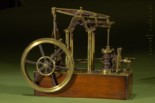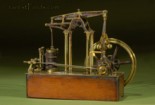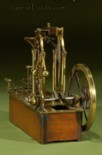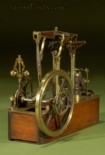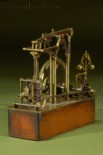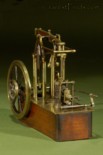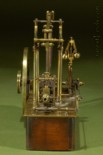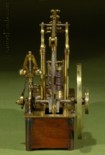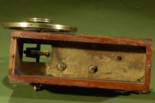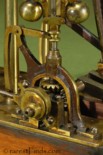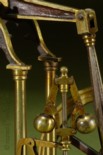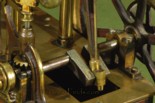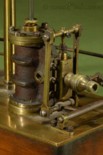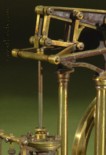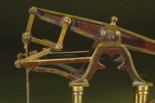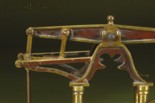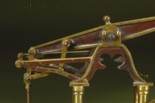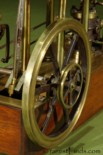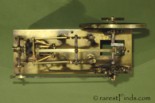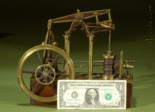Exceedingly rare and early model of a four column rotative James Watt vertical steam engine of the reciprocating beam type with double-action low-pressure single-cylinder, Watt's “parallel motion” linkage, and Watt's centrifugal speed governor. Sold!
The wood base measures 9 by 3-1/4 by 2-1/4 inches, the brass base plate 9-3/16 by 3-5/16 by 1/8 inches. Including the wood base, the model measures 5 by 10-1/2 by 8-1/2 inches high. The cylinder has a stroke of 1 inch and a bore of 3/4 of an inch. The flywheel diameter measures 5-1/4 inches, the diameter of the integrated pulley to power machinery by a belt measures 1-3/4 inches. The weight is 4 lbs and 4 ounces.
The crankshaft is forged and/or machined of one piece of steel. The beam is not connected to the flywheel axis by Watt's “sun and planet” gear typically used in the 18th century (pre 1800), as Pickard's patent on the crankshaft used in steam engines expired in 1799; thereafter there was no need to circumvent his patent any-longer with Watt's more complex “sun and planet” gear. The frame supported by the four columns holding the shaft of the beam and which provides the anchor point for Watt's “parallel motion” of this model, as well as other parts, are made of cast brass or cast bronze, indicating that this model was manufactured and not a unique model crafted by a skilled machinist.
Condition:
This fine model is all original and dates to around 1820. Plese note that this model still has the four column support for the top bearing block for the beam and is not of the center column type typical for the mid 19th century, or the time after 1840, manufactured by companies like, William Fairbairn, Sanderson of Glasgow, Stuart, and others. Inbetween, for a short periode of time, around 1830, the beam support was typically effectuated by two triangular side supports for the top bearing block. However, Stothert & Pitt from Bath, exhibited an engine with four column design as late as 1867 at the Universal Exhibit of 1867 in Paris, France. The four columns of the exhibited steam-engine were ornately braced for stability and not free standing.
It is impossible to find an original model from this period, there are many manufacturers which make modern 1:12 scale copies, such as Coles, P. Dunham, Cotswold Heritage, Exactus, George Gentry, R.P. Hains, Home Model Engine Machinist (HMEM), Millhill Supplies Ltd., Polly Engineering, A. J. Reeves Castings, Stuart Live Steam Models, Traplet, and Edgar Westbury.
Originally the brass parts of the mmodel offered here were fire-gilded (see picture #19, around the four colums supporting the beam and right next to the bearing of the crank shaft on the model's side of the flywheel). Fire gilding is a technique used in the 18th and 19th century and was abandoned once the harmfull effects of mercury, which plays a crucial role in the process, was discovered. Most of the gold is worn off over time as can be clearly seen in the pictures. The un-machined surfaces of the cast parts are painted. There is a small piece of wood missing from the base, see pictures #3, 4, 8, and 9. To protect the model, I have not tried to run it with steam or compressed air but do not see any reason why this model would not run as intended if steam or compressed air would be applied. Everything moves freely. There are no repairs or defects.
The largest collection of steam-engine model pictures you will find at the website of stationroadsteam.com, pictures of more then 600 models. To see pictures,
click here!
History:
By the late 17th century, a national shortage of wood had created a lively demand for coal as a substitute fuel. Besides the demand for cooking and heating fuel for an ever increasing number of stately mansions, oak trees were also used to build ships. To build an 18th Century ship to sail the world's oceans 2,000 oak trees were needed. Britain possessed huge reserves of coal, but the extraction of these required deep mines, and the curse of mines was their tendency to fill up with water.
It was Thomas Savery (1650-1715) who invented the first steam powered device or fire-engine to pump water out of mines; his patent issued in 1698 and was to protect his idea for the next 14 years. However, just the next year, 1699, the parliament enacted the “Fire-Engine Act,” protecting Savery's patent for the next 21 years.
Thomas Newcomen (1663-1729), improved Savery's invention and was forced to go into a partnership with Savery to patent his improved fire-engine in 1712. Newcomen supplied the coal industry with the tool for colossal expansion by providing a reliable pumping machine. Newcomen's machines were reliable but highly inefficient.
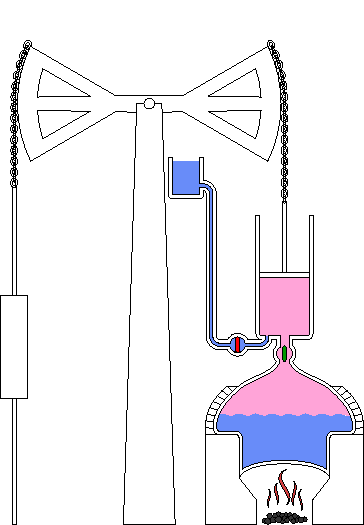 This did not pose a problem, as Newcomen's fire-engines consumed the unwanted “small coal" that was a waste material at collieries. Newcomen's fire-engine had tremendous ramifications for the British economy and led, among other things, to a rapid transition to coal fuel by British industries.
This did not pose a problem, as Newcomen's fire-engines consumed the unwanted “small coal" that was a waste material at collieries. Newcomen's fire-engine had tremendous ramifications for the British economy and led, among other things, to a rapid transition to coal fuel by British industries.
Despite its brilliant conception, Newcomen's fire-engine remained for some decades a rough-and-ready sort of apparatus, assembled by local millwrights and blacksmiths. Newcomen's engine design was reliable but the high fuel consumption restricted its use to pump water out of mines of the coalfields and the richer metal mines of the 18th century, such as Cornwall and Devon, where the tin and copper mines urgently needed better pumps.
Newcomen's steam engine was an engine working not on the pressure of expanding steam, but on a partial vacuum as the power to pull down the horizontal beam was created by condensing the steam inside the cylinder. To achieve this, Newcomen invented the internal-condensing jet for obtaining a partial vacuum in the cylinder; an automatic valve gear timed the inlet of steam into the cylinder and cold water to the jet to cool down the steam, see animated model of a typical Newcomen fire-engine on the left.
By using steam at atmospheric pressure, he kept within the working limits of his materials. The pressure inside any of Newcomen's engine did not exceed atmospheric pressure, hence its name, the Newcomen's Atmospheric engine. The overall thermal efficiency was only about 0.5% ! The cause of this wastefulness was the heating and cooling of the cylinder at every stroke.
Newcomen died in 1729 at the age of 66. By 1775, about 600 Newcomen engines had been built. Over time, the fire-engine became referred to as the steam-engine and made the Industrial Revolution possible, but before it could play this part, it had to be further refined from the crude atmospheric machine invented by Savery and improved by Newcomen.
The man who made the steam engine practical by substantially increasing its efficiency was born in 1736, seven years after Newcomen's death. His name, James Watt (1736 – 1819).
James Watt was one of the most important engineers and scientists in history. His father was able to provide his son James with a very creative and multifaceted environment which led James Watt to pursue studies at a young age of geometry, Greek, and Latin, while working in his fathers shop making delicate models. He then worked in Glasgow and later in London to improve himself as an mathematical and philosophical instrument maker, working as an apprentice of John Morgan of Finch Lane, in Cornhill. Watt eventually was appointed as mathematical instrument maker to the university of Glasgow. In 1764, twenty-eight years old, Watt was asked to repair a model of a Newcomen fire-engine used at the university of Glasgow as a demonstration model. The poor performance of the model caught Watt's curiosity and laid the foundation to Watt's first and greatest invention.
Watt's invention of the Separate Condenser:
With this invention, Watt reduced the fuel consumption of the steam engine by up to 80%, which translates into a thermal efficiency of up to 2.5%, instead of 0.5%.
His subsequent work on the modern steam engine kick-started the entire Industrial Revolution. Many believe that James Watt invented the steam engine. Unfortunately, Thomas Savery and Thomas Newcomen are not widely known for their achievements. However, it was James Watt who perfected the design with his many improvements and made the steam engine the locomotive of the Industrial Revolution. For lack of funding, Watt did not pursue his invention for the next five years, he was busy making surveys and writing reports in connection with canals, rivers, and harbours.
In 1767, Watt was introduced to Matthew Boulton, the founder of the Soho Engineering Works, near Birmingham. Two years later, on January 5, 1769, James Watt received his patent for his greatest invention, the separate condenser. The title of the patent is, “Method of lessening the consumption of steam and fuel in fire-engines, separate condenser.”
In 1775, Watt entered a partnership with Boulton who became one of his close friends and together they founded the firm Boulton & Watt. By this time, about 600 Newcomen fire-ngines were built, all reciprocating and not rotative type beam engines.
Up to this point, fire-engines or steam-engines were used to pump water, they had no need for a flywheel. The condensing steam created a partial vacuum in the piston, pulling down a chain attached to one end of the beam. See animated model of a typical Newcomen fire-engine at the upper left.
 At the end of the cycle and the beginning of the next cycle, the filling of the piston with steam together with the weight of the pump at the other end of the beam raised the beam at the side the piston was attached. The time to pull the beam down was different from the time it took to move the beam up and not conducive to power a flywheel of a constant speed. James Watt came up with the idea of the double action piston; the piston should not only pull down the beam, the piston should also push the beam up in order to have a harmonic action. Using the piston in both directions doubled the work of a given size of the piston while equalizing the time used for the up and down motion of the beam. With such a continues action, a flywheel could be attached and the steam engine used for other work by driving machinery, not only to pump water.
At the end of the cycle and the beginning of the next cycle, the filling of the piston with steam together with the weight of the pump at the other end of the beam raised the beam at the side the piston was attached. The time to pull the beam down was different from the time it took to move the beam up and not conducive to power a flywheel of a constant speed. James Watt came up with the idea of the double action piston; the piston should not only pull down the beam, the piston should also push the beam up in order to have a harmonic action. Using the piston in both directions doubled the work of a given size of the piston while equalizing the time used for the up and down motion of the beam. With such a continues action, a flywheel could be attached and the steam engine used for other work by driving machinery, not only to pump water.
Watt realized to late that using a crank to convert the up and down movement of the reciprocating beam into a rotative motion was not to trivial of an issue but also an idea worthy of protection. Unfortunately, James Pickard had patented the crank and flywheel in 1780. (patent no. 1263), forcing Watt to pay royalties or to come up with a way around the crank and flywheel concept.
Watt's invention of the “sun-and-planet” gear:
Watt came up with his brilliant idea of the “sun-and-planet” gear and patented his idea on October 25, 1781 (no. 1306). The patent title is aptly, “New methods to produce a continued rotation motion – sun and planet. “
Watt's invention of the “double-action” piston:
Having learned his lesson, Watt saw the urgency in protecting his idea of the double action piston and applied for a patent which was issued in 1782 (No. 1321). The title of this patent is, “Steam or fire-engine for raising water, and for other mechanical purposes; mechanism application to the same.” This patent also embraced another most important principle in the use of steam, the force of steam used expansively, overpowering athmospheric pressure istead of using it by creating partial vacuums using atmospheric pressure; the principle used to increase efficiency of steam-engines post the year 1800. Hence, nobody else was able to use steam pressure to move a piston without Watt's permission.
In previous engines, the single action type engines built by Newcomen and Watt, the piston pulled one end of the walking beam downwards during the power stroke using a chain, and the weight of the pump pulled the other end of the beam downwards during the recovery stroke using a second chain. The alternating forces are producing the rocking motion of the beam. In Watt's new double-action engine, the piston produced power on both the downward and upward strokes, so a chain could not be used to transmit the force to the beam. The chain could also not just simply be replaced by a rod, as the ends of the beam moved in a circular motion around the center of the beam. The rod of the piston had to move straight up and down. To solve this problem, Watt made his next invention.
Watt's invention of the “parallel motion” linkage:
Watt invented the parallel motion to transmit force in both directions whilst keeping the piston rod vertical. He called it "parallel motion" because both the piston and the pump rod were required to move vertically, parallel to one another. Please note the animated image demonstrating Watt's “parallel motion” linkage.
James Watt was most proud of the invention of the “parallel motion”; he described it as, “one of the most ingenious, simple pieces of mechanism I have contrived.” In a letter to his son in 1808 describing how he arrived at the design, James Watt wrote “I am more proud of the parallel motion than of any other invention I have ever made.” James Watt wrote this letter to his son 24 years after he patented his idea on August 25, 1784 (no. 1432), together with six additional improvements of his steam engine.
Some scientists argue that the design of the parallel motion (or double-acting engine) in 1784 should serve as the starting point of the Anthropocene Epoch - the unofficial interval of geologic time in which human activity began to substantially alter Earth's surface, atmosphere, and oceans. (The term Anthropocene was coined by Nobel prize-winning scientist Paul Crutzen in 2000.)
The incredible model offered for sale here does also incorporate the “parallel motion” linkage invented by James Watt.
In 1786, Watt's business partner Matthew Boulton suggested the adoption of the centrifugal governor for automatic control of the speed of their steam engines and Watt took on his suggestion and applied it successfully. The model offered here also incorporates the automatic centrifugal governor which operates a steam valve to regulate the supply of steam to the piston to control the speed of the model.
But James Watt had other interests and made other, lesser known, but important and ground-breaking inventions.
Being a very involved business man, he had a lot of reports and correspondence in form of letters and contracts to write. At the time, there was nothing available to copy written materials; the only way to secure a copy of ones work was to write the same twice. This was consuming a lot of time and forced James Watt to invent the first copy machine, which he patented in 1780 (patent no. 1244).
By 1790 Watt was a wealthy man, having received £76,000 in royalties on his patents in eleven years, of which Watt spent £6,000 in litigation to protect his patents. In 1800, Watt's patent of 1769 finally expired and he retired from the firm of Boulton & Watt. Matthew Boulton retiring at the same time, he and Watt left the business to their sons, James Watt, junior, and Matthew Robison Boulton. Watt died at Heathfield, in his eighty-fourth year, and was buried in St. Mary's Church at Handsworth (now a suburb of Birmingham).
James Watt is considered the father of the industrial revolution. He was elected fellow of the Royal Society of London in 1785. In his honor, the international unit of power is called in his name; power is equivalent to a unit of work divided by a unit of time. Thus, a Watt is equivalent to a Joule/second.
For furter reading, I would recommend the book, "LIFE OF RICHARD TREVITHICK, WITH AN ACCOUNT OF HIS INVENTIONS, by Francis Trevithick, Volume I."
Richard Trevithick proposed to use high pressure steam instead of using athmospheric pressure to power the pumps used in mines, and at the beginning of the 19th century, in his road and later track locomotives. In that sense, he was ahead of Watt who did not believe in using high pressure steam. There is also an interesting account of environmental pollution dating back to the year 1739 (page 15), and much more. To read the book,
Inventory Number 09329;
Sold!
